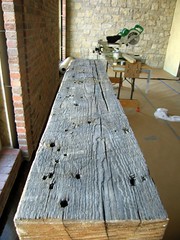 Image by proforged via FlickrBy Patrick Preston
Image by proforged via FlickrBy Patrick PrestonWhat on Earth is Reclaimed Wood?
7:30pm. On time. You've entered into the eating house Wayne and Nara have been bragging about. The entire ambiance buzzes from discussion and laughter. All of the bartenders politely assist men and women waiting right behind the grey and green marble bar. Wax lights improve a dim yet tension free ambience. After which you detect it.
The walls seem to be adorned in some of the most amazing wood you've really noticed. Ripples of golden darkish brown and even dark chocolate unite within each plank of wood, effortlessly fastened plank by plank. The totally exposed wood beams beautifully stay overhead, aged and solid in their position. And hence your current mission for Reclaimed Wood began when you least envisioned it.
Precisely what is it?
Reclaimed wood is re-collected wood that has been historically utilized within a different building or structure. If this particular building or structure is ripped down, all of the wood that is accumulated and re-used in a different establishment or project is in fact known as Reclaimed Wood.
Hefty wooden supports out of worn out barns, industrial facilities or warehouses are usually some of the widely picked up Reclaimed Wood pieces. Ordinarily these enormous pieces are then simply machined down directly into manageable, lumber pieces - planks - sizes of which are normally noticed at your city wood distributor. Although with this being mentioned, virtually any wood which can potentially be re-used - envision wood flooring, walls, barn siding and far more - should be able to be picked up, re-used and known to be Reclaimed Wood.
Precisely what is the draw of Reclaimed Wood?
Like a high-quality Scotch truly does, as wood becomes older it can also fully develop undoubtedly well. Rather than flavor, you'll discover that this wood can develop completely brilliant colors, impressive patterns, and extraordinary appearances.
The tones grow after some time. A variety of factors come into play. The trees conditions - the actual time-span of winter months and summer months, the variety of nutrients the tree may have access too - and the actual kind of tree are generally some of the most notable components. Nevertheless as soon as a tree is chopped down and machined into wood, there seem to be various other factors which help determine the woods tone.
Imagine, throughout the course of 190 years, a one piece of wood from a vintage manufacturing plant or development could possibly have experienced countless distinct finishing treatment methods, layers of painting and all sorts of oils. Every different treatment method might have seeped in to the wood, and accordingly helped to cultivate its outstanding shade. Blended together with the large selection of grain patterns - colour/design versions actually are limitless.
What does Reclaimed feel like?
The feel of the wood will certainly change depending on the piece itself. As an example, reclaimed wood that has been through the snow and rain of 150 years feels completely un-like almost any piece of lumber you've chosen at your community wood retailer. Provided that you've held a 150yr old Barn Board Siding you'll understand precisely what I'm talking about. The humps, grooves, and swirls are undoubtedly not like all others.
You truly can't "make" this particular kind of wood. It simply ages in to being.
Pitch a little bit of historical background in the mix, and you've got an exceptionally special product. The old Barn Board mentioned above. Just why not re-use it for a bookcase? 1805 Chapel Oak - buried beneath tones of dirt for years? Let's re-use the very beams on your lounge room ceiling, or make an elegant dining room table.
Yet, there's more charisma to this wood. The geographical impact is extremely positive. As an example, as Designers and Architects know, gathering up LEED credits for wood is remarkably difficult. Yet Reclaimed Wood quickly qualifies for LEED credits resulting from its praiseworthy ecological impact.
What does this mean for your Reclaimed Hardwood Floor or Kitchen Table? It means you'll benefit from an exceptional, historical and eco friendly piece that your family and friends will treasure for many years to come. Reclaimed Wood is an alternative you should probably think about on your next wood related investment or venture.
Serious in finding out even more about Reclaimed Wood, Salvaged Wood, What to Consider Before Buying, How to Treat Reclaimed Wood and other questions? Join the discussion with Reclaimed Wood Canada dot com. It's free, and is jam packed with content and resources.
Article Source: http://EzineArticles.com/?expert=Patrick_Preston
http://EzineArticles.com/?Reclaimed-Wood?-What-on-Earth-Is-That?&id=5702775

No comments:
Post a Comment